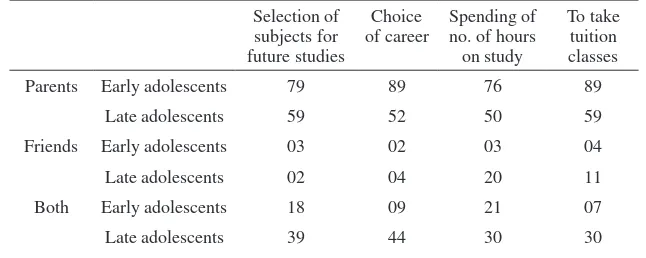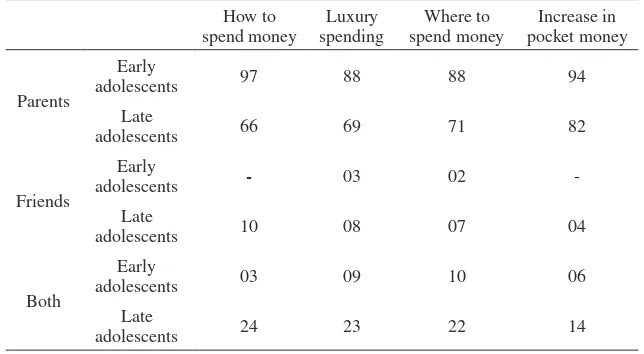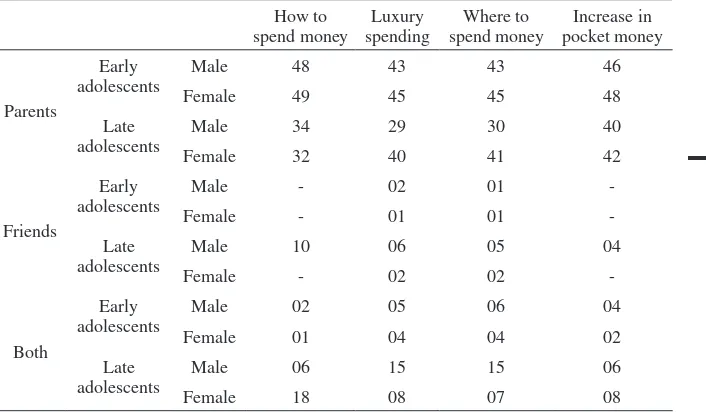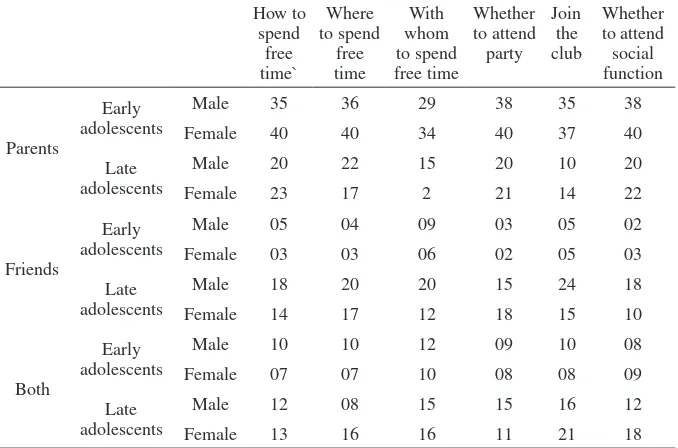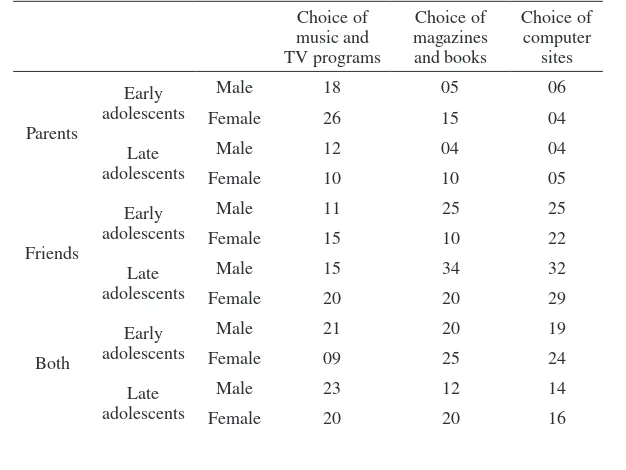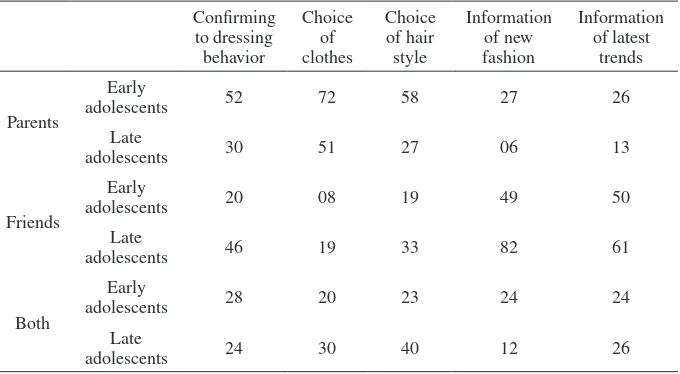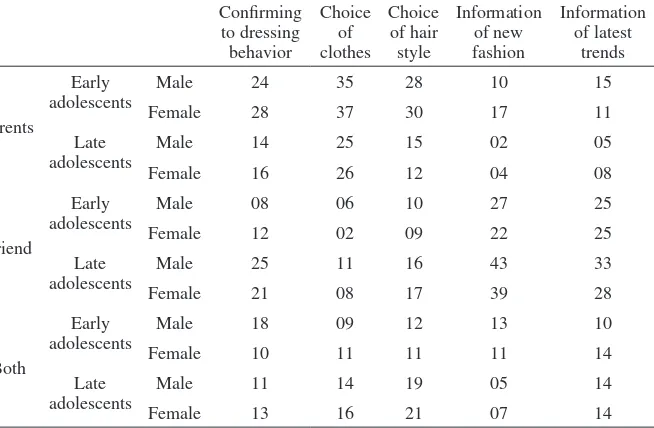Issues and Ideas in Education Vol. 2, No. 2 September 2014 pp. 115–130 DOI: 10.15415/iie.2014.22009
Relative Influence of Parents and Peers on
Adolescents in Decision Making
AgNESE DhIllON
Dev Samaj College of Education Sector 36-B, Chandigarh–160036, India
Email: agnesedhillon@gmail.com
Received: May 28, 2014| Revised: August 8, 2014| Accepted: August 8, 2014
Published online: September 25, 2014
The Author(s) 2014. This article is published with open access at www.chitkara.edu.in/publications
Abstract: The present study was conducted to study the relative influence of parents and peers on adolescents’ in decision making. The sample comprised 200 adolescents of class VII and XII of which 100 were boys and 100 were girls. The sample for the research was selected by the descriptive survey method. The tool that was used for the data collection was Decision Making Test developed by the investigator. The students were given the questionnaire and the responses were collected. The data was analyzed using percentages keeping in mind the aims and objectives of the study. The results of the study show that the adolescents consulted their parents in all the matters but their decisions in few areas only was affected by the parents.
Keywords: Decision making, relative influence, parents, peers, adolescents
1. IntRoDuctIon
Dhillon, A. influences their children’s susceptibility to negative peer influence. Overall it appears that adolescents face a lot of stress in their transition from a dependent child to an independent adult. Parents and peers play a crucial role in helping the adolescent become socially and emotionally mature. One of the most important human skills is decision making. It is an inevitable function both at personal level and in content of organization.
Dutta, Bratha and goswami (1998) and Wentzal and Caldwell (1997) reported that peer relationships of young adolescents are related to academic achievements in complex ways. Peer relationship variables are significantly predictors of students’ grades both currently and overtime. This served varied functions in academic lives of young adolescents. Peer acceptance is positively related with academic achievement.
horn (1999) found that adolescents do not become captives of friends. Peers actually reinforce different parental values. Peers do not influence specific areas such as music, fashion, language. however, parents tend to be predominant in areas underlying moral and social values and in understanding the adult parental world.
Parental involvement also leads to self confidence; high self-esteem is thought to support in both friendship and romantic relationship. In late adolescents, they reflect the features of attachment and care giving system. (e.g. communication, seeking support or providing support) (Conolly et al., 2000).
Sandhu (2001) reports that majority of adolescents talk frequently with their parents about their problems related to any issue, personal, educational and vocational.
A comparative study done by Kanchana (2002) reports that Indian college students have lower career decision making and self-efficacy as compared to American counterparts, probably due to lack of adequate exposure to different areas of study/ vocation with greater role that parents and elders play in adolescents decision making.
hurria (2003) in his study reported that parents give priority to fashion needs of adolescents especially mothers tried to plan and update their adolescent’s wardrobe. They often went their way to make special effort for getting party dresses. They tried their level best ensuring that adolescents satisfied with kind of dresses they possess.
Relative Influence of Parents and Peers on Adolescents in Decision Making 2. neeD of the stuDy
There is strong evidence that parents remain highly influential people in the lives of adolescents. Adolescents remain in rich network of peers, but it does not mean they follow the dictates of their peers. They find themselves comfortable in discussing their personal problems with their friends. Too little or less information can be dangerous and can be futile.
Thus, parents need to bring about more openness in their communication with the adolescents. It helps foster closer relationships which help them in making good decision. Adolescents need to be handled with love and care. They need to be monitored appropriately and guided properly for making appropriate decision. Parents need to spend quality time with their children. When adolescents are together with their parents, they are likely to be participating in positive behaviors. Parents also need to pay attention towards their children’s peers. It helps children make good choice about with whom to make friends. Parents can approach their children and their friends with confidence and can have positive impact, making their children well adjusted individuals of the society. The study will help in identifying the areas where adolescents are influenced by them and also to make an effort to be closer to adolescents in these areas. The study will also help to understand the importance of parents and peers in long and short term decisions of adolescents.
3. objectIves
To study the relative importance of opinion of parents and peers in early 1.
and late adolescents’ decision making.
To study the relative influence of parents and peers in different areas of 2.
adolescents’ decision making.
To study the gender differences in reference to relative influence parents 3.
and peers in adolescents in different areas of decision making.
4. hyPotheses
There exists relative importance of opinion of parents and peers in early 1.
and late adolescents’ decision making.
The relative influence of parents and peers will be different in different 2.
areas of adolescents’ decision making.
The relative influence of parents and peers will be different in different 3.
Dhillon, A. 5. DesIgn of the stuDy
In the present study, survey method of research was used. The present study was primarily designed to see the relative influence of parents and peers in early and late adolescents’ decision making and also to identify particular areas where these groups of adolescents seek the advice of parents and peers.
6. sAMPlIng technIque
The data for the present study was collected personally by the investigator. The students of class 7th and 12th were approached through the heads of the
institutions. Random sampling was used for the selection of the sample for the study.
7. sAMPle
In this study, a sample of 200 adolescents, 100 each from early and late adolescents, (50 boys and 50 girls from each group). The early adolescents were in the age group 12-13 years and late adolescents were in the age group 18-19 years. The sample belonged to low socio- economic status.
8. tools useD
Following tools were employed in the present study: Decision Making Test developed by the investigator. 1.
The tool was pre-tested on a pilot sample of 10 early and 10 late adolescents to check the applicability and ease of administration of the questionnaire. But was not standardized by taking the expert opinion.
9. stAtIstIcAl AnAlysIs
The data was analyzed with the help of percentages according to aims and objectives of the study.
10. Results
Relative Influence of Parents and Peers on Adolescents in Decision Making
The decision to take up tuition classes was again influenced by parents. Early adolescents remain more influenced by parents as compared to late adolescents. Parents were mostly preferred in decision related educational areas that have long term consequences which directly affect the future of the adolescents. late adolescents however depended on friends for some decisions. So, the hypothesis “there exists relative importance of opinion of parents and peers in early and late adolescents’ decision making” is accepted.
table 1: Adolescents’ preference to parents, peers or both in educational/vocational
areas.
Selection of subjects for future studies
Choice
of career Spending of no. of hours on study
To take tuition classes
Parents Early adolescents 79 89 76 89
late adolescents 59 52 50 59
Friends Early adolescents 03 02 03 04
late adolescents 02 04 20 11
Both Early adolescents 18 09 21 07
late adolescents 39 44 30 30
table 2: Adolescents’ preference to parents, peers or both in educational/vocational
area sex wise.
Selection of subjects for future studies
Choice of career
Spending of no. of hours
on study
To take tuition classes
Parents
Early
adolescents FemaleMale 3841 4247 3739 4544
late
adolescents FemaleMale 3128 3022 2723 3029
Friends
Early
adolescents FemaleMale 0201 02- 0201 0301
late
adolescents FemaleMale 02- 04- 1505 0605
Both
Early
adolescents FemaleMale 1008 0603 1110 0205
late
Dhillon, A. Table 2 shows that majority of both sexes of early and late adolescents remain mostly influenced by their parents in choice of career and selection of future studies. however, late male adolescents consider their friends for spending number of hours at studying and to take up tuition classes, however the percentage of girls remained less. This may be due to the fact that boys and girls show great trust in their parents for their long term decisions such as their educational plans. Moreover, parents are also getting involved in their children’s study. So, the hypothesis “the relative difference of parents and peers will be different in different areas of adolescents’ decision making due to gender differences” is accepted.
Table 3 shows the decisions related to financial matters. Early and late adolescents are greatly influenced by their parents as compared to friends. Adolescents are influenced by their parents as how and where to spend money, luxury spending and increase in their pocket money. Again early adolescents remained much influenced by their parents as compared to late adolescents. This could be due to the fact that financial matters is a family activity and parents also feel responsible to take care of their children’s financial needs. So, the hypothesis “there exists relative importance of opinion of parents and peers in early and late adolescents’ decision making” is accepted.
Table 4 shows that there were no major sex differences for both early and late adolescents in regard to financial matters. Results show that both male and female adolescents take their financial decisions under the influence of their parents. This may be due to the fact that boys and girls rely on their parents for their financial matters. So, the hypothesis “The relative difference of parents
table 3: Adolescents’ preference to parents, peers and both in financial matters
how to
spend money spendingluxury spend moneyWhere to pocket moneyIncrease in
Parents
Early
adolescents 97 88 88 94
late
adolescents 66 69 71 82
Friends
Early
adolescents - 03 02
-late
adolescents 10 08 07 04
Both
Early
adolescents 03 09 10 06
late
Relative Influence of Parents and Peers on Adolescents in Decision Making
and peers will be different in different areas of adolescents’ decision making due to gender differences” is rejected.
Table 5 reveals that in the area of socialization, majority of early adolescents largely remained influenced by their parents. however, majority of late adolescents remained influenced by their friends in as how, where and
table 4: Adolescents’ preference to parents, peers or both in financial matters by sex.
how to
spend money spendingluxury spend moneyWhere to pocket moneyIncrease in
Parents
Early
adolescents FemaleMale 4849 4345 4345 4648
late
adolescents FemaleMale 3432 2940 3041 4042
Friends
Early
adolescents FemaleMale -- 0201 0101 -
-late
adolescents FemaleMale 10- 0602 0502 04
-Both
Early
adolescents FemaleMale 0201 0504 0604 0402
late
adolescents FemaleMale 0618 1508 1507 0608
table 5: Adolescents’ preference to parents, peers or both in the area of socialization.
how to spend free time
Where to spend free
time
With whom to spend free time
Whether to attend
party Join
the club
Whether to attend social
function
Parents
Early
adolescents 75 76 63 78 72 78
late
adolescents 43 39 37 41 24 42
Friends
Early
adolescents 08 07 15 05 10 05
late
adolescents 32 37 32 33 39 28
Both
Early
adolescents 17 17 22 17 18 17
late
Dhillon, A. with whom they spend their time; attend parties; social functions and joining of clubs. This may be due to the reason that adolescents shift to their peers with increase in age as they are spending more time with each other and expanding their social worlds. So, the hypothesis “The relative influence of parents and peers will be different in different areas of adolescents’ decision making” is accepted.
table 6: Adolescents’ preference to parents, peers or both in the area of socialization
by sex.
how to spend
free time`
Where to spend
free time
With whom to spend free time
Whether to attend party
Join the club
Whether to attend social function
Parents
Early adolescents
Male 35 36 29 38 35 38
Female 40 40 34 40 37 40
late adolescents
Male 20 22 15 20 10 20
Female 23 17 2 21 14 22
Friends
Early adolescents
Male 05 04 09 03 05 02
Female 03 03 06 02 05 03
late adolescents
Male 18 20 20 15 24 18
Female 14 17 12 18 15 10
Both
Early adolescents
Male 10 10 12 09 10 08
Female 07 07 10 08 08 09
late adolescents
Male 12 08 15 15 16 12
Female 13 16 16 11 21 18
Table 6 shows that majority of male and female in early adolescence remained influenced by their parents in all matters of socialization; however both boys and girls like to spend to spend their free time with their friends. In late adolescence both male and female remained more peer oriented. So, the hypothesis “The relative influence of parents and peers will be different in different areas of adolescents’ decision making due to gender differences” is accepted.
Relative Influence of Parents and Peers on Adolescents in Decision Making
read, they again remained more influenced by their parents. This may be due to the fact that late adolescents share common interest, as they share more of their time together in the company of their peers. On the other hand, early adolescents, being still parent compliant because of greater dependency and more parental control. So, the hypothesis “The relative influence of parents and peers will be different in different areas of adolescents’ decision making” is accepted.
Table 8 shows that there were no major sex differences in decision regarding choice of leisure time activities. Majority of both male and female
table 7: Adolescents’ preference to parents, peers or both in leisure time activities.
Choice of music
and TV programs Choice of magazines and books computer sitesChoice of
Parents Early adolescents 44 20 10
late adolescents 22 14 09
Friends Early adolescents 26 35 47
late adolescents 35 54 61
Both Early adolescents 30 45 43
late adolescents 43 32 30
table 8: Adolescents’ preference to parents, peers or both in leisure time activities by
sex.
Choice of music and TV programs
Choice of magazines and books
Choice of computer
sites
Parents
Early adolescents
Male 18 05 06
Female 26 15 04
late adolescents
Male 12 04 04
Female 10 10 05
Friends
Early adolescents
Male 11 25 25
Female 15 10 22
late adolescents
Male 15 34 32
Female 20 20 29
Both
Early adolescents
Male 21 20 19
Female 09 25 24
late adolescents
Male 23 12 14
Dhillon, A. early adolescents remained largely influenced by their parents; however the influence was more for females. Both the sexes in late adolescence remained peer oriented in choice of music, TV programs, book and magazines to read and computer sites to visit. This may be due to the reason that adolescents rely on their peers for decisions that have short term values. So, the hypothesis “The relative influence of parents and peers will be different in different areas of adolescents’ decision making due to gender differences” is rejected.
table 9: Adolescents preference to parents, peers ort both in financial matters.
Confirming to dressing behavior
Choice of clothes
Choice of hair style
Information of new fashion
Information of latest
trends
Parents
Early
adolescents 52 72 58 27 26
late
adolescents 30 51 27 06 13
Friends
Early
adolescents 20 08 19 49 50
late
adolescents 46 19 33 82 61
Both
Early
adolescents 28 20 23 24 24
late
adolescents 24 30 40 12 26
Table 9 shows that majority of early adolescents remained largely influenced by parents in area of fashion. It was observed that late adolescents were mostly under the influence of their peers in confirmation to dressing behavior (46%) and they are getting information on new fashion and trends from them (82%) and (61%) respectively. On the other hand, early adolescents were more parents compliant in the area of fashion. The reason could be again due to similarity of likes and dislikes and dependency on parents for their financial needs. Moreover, it can be due to parents’ interest in their adolescents needs. So, the hypothesis “There exists relative importance of opinion of parents and peers in early and late adolescents’ decision making” is accepted.
Relative Influence of Parents and Peers on Adolescents in Decision Making
table 10: Adolescents’ preference to parents, peers or both in financial matters by
sex.
Confirming to dressing
behavior
Choice of clothes
Choice of hair style
Information of new fashion
Information of latest
trends
Parents
Early
adolescents FemaleMale 2428 3537 2830 1017 1511
late
adolescents FemaleMale 1416 2526 1512 0204 0508
Friend
Early
adolescents FemaleMale 0812 0602 1009 2722 2525
late
adolescents FemaleMale 2521 1108 1617 4339 3328
Both
Early
adolescents FemaleMale 1810 0911 1211 1311 1014
late
adolescents FemaleMale 1113 1416 1921 0507 1414
table 11: Adolescents preference to parents, peers or both in area of personal
matters.
Choice of friends of opposite
sex
Discussion of school problems
Discussion of problems with friends
Discussion of relationship with opposite
sex
Information of sex
Parents
Early
adolescents 44 41 50 21 28
late
adolescent 27 25 15 12 05
Friends
Early
adolescent 23 27 27 48 39
late
adolescent 53 39 55 63 73
Both
Early
adolescent 33 32 23 31 33
late
Dhillon, A. that with increase in age, there is a shift of conformity to peers in decisions relating to current status. So, the hypothesis “The relative influence of parents and peers will be different in different areas of adolescents’ decision making due to gender differences” is rejected.
Table11 shows that majority of early adolescents remained influenced by their parents in decision of choice of friends of opposite sex. Most of the early adolescents relied on their parents in regard to discussion of school problems and problems with friends but in discussion regarding relationship with opposite sex, majority of early adolescents remained influenced by peers. Results also show that majority of late adolescents remained influenced by their friends in all personal matters. however, in question item related to information on sex, showed that majority of early adolescents and also late adolescents refer to their friends. This could be due to the reason that sex is
table 12: Adolescents’ preference to parents, peers or both in area of personal matters
by sex.
Choice of friends
of opposite
sex
Discussion of school problems
Discussion of problems
with friends
Discussion of relationship
with opposite
sex
Information on sex
Parents adolescentEarly Male 20 21 23 08 03
Female 24 20 27 13 25
late
adolescents Male 09 10 03 03 02
Female 18 15 12 09 03
Friend adolescentsEarly Male 14 14 14 27 27
Female 09 13 13 21 12
late
adolescents Male 36 24 35 37 39
Female 17 15 20 26 34
Both adolescentsEarly Male 16 15 13 15 20
Female 17 17 10 16 13
late
adolescents Male 05 16 12 10 09
Relative Influence of Parents and Peers on Adolescents in Decision Making still considered to be a taboo in our society and is not discussed much with
parents. Peers, on the other hand, act as consultant or guides in their personal matters and relationships. So, the hypothesis “There exists relative importance of opinion of parents and peers in early and late adolescents’ decision making” is accepted.
Table 12 shows that majority of late adolescents remain more influenced by their peers in the personal matters as compared to females. So, the hypothesis “The relative influence of parents and peers will be different in different areas of adolescents’ decision making due to gender differences” is accepted.
11. eDucAtIonAl IMPlIcAtIons
There is strong evidence that parents remain highly influential people in the lives of adolescents. Further research confirm the fact that tendency to conform to peers increases with age and is situation specific. The study will help parents in identifying the areas where adolescents are influenced by them and also to make an effort to be closer to adolescents in these areas. The study will also help to understand the importance of parents and peers in adolescents short and long term decisions. This study also shows that vocational interests of boys and girls differ partially. Many of their preferences are same, like both of them prefer scientific, executive, artistic, persuasive, social and household fields. The findings of present study have very important implications for teachers, administrators and for guidance workers so that they can offer the students the opportunities to choose their subjects according to their interest in order to prevent misfits in later stages of their lives. Overall, this study suggests that adolescents will seek their parent’s advice and opinion for long term, important and difficult decisions, whereas friends’ opinions and feelings will be more important for decisions in short-term, less important and less difficult areas. As Floyd and South have noted, parents and peers ability and willingness to help meet specific needs for the adolescents are central factors in reference orientation.
12. AnnexuRe
Parents and peers influence on adolescents’ decision making in six different areas
educational/vocational
Your decision of selection of subjects/courses for present and future studies 1.
depends upon?
Dhillon, A. 2. Your decision of choosing your career will depend upon?
Parents friends both parents and friends Your decision of spending number of hours at studying depends upon? 3.
Parents friends both parents and friends Your decision of taking up tuitions will depend upon?
4.
Parents friends both parents and friends
12.1 financial matters
For you the amount of money spent is largely dependent upon? 5.
Parents friends both parents and friends Who will influence you most on your luxury spending?
6.
Parents friends both parents and friends Who influences you as to where to spend your money?
7.
Parents friends both parents and friends The decision for an increase in pocket money is influenced by?
8.
Parents friends both parents and friends
12.2 socialization
Who influences your decision regarding how to spend your time after 1.
school/college?
Parents friends both parents and friends Who influence your decision regarding where to spend your time after 2.
school/college
Parents friends both parents and friends With whom do you like to spend most of your free time?
3.
Parents friends both parents and friends Your decision of attending a party depend s upon?
4.
Parents friends both parents and friends If you are join a club whose opinion you consider most important? 5.
Parents friends both parents and friends Whose opinion you consider most important while deciding any of social 6.
event/ function?
Relative Influence of Parents and Peers on Adolescents in Decision Making 12.3 leisure
Whose choice of music and TV programs do you depend upon? 1.
Parents friends both parents and friends Who influences on your choice of magazines and books to read?
2.
Parents friends both parents and friends Whose opinion will you consider to visit sites on computer?
3.
Parents friends both parents and friends
12.4 fashion
Your dressing behavior is most likely to be in conformity with? 1.
Parents friends both parents and friends Your choice of clothes depends largely upon?
2.
Parents friends both parents and friends If you are to change to a new hairstyle, whose opinion will you consider 3.
most?
Parents friends both parents and friends Who gives you latest information about new fashion?
4.
Parents friends both parents and friends From whom do you get information about latest trends in the market? 5.
Parents friends both parents and friends
12.5 Personal matters
In choosing a friend of opposite sex, whose opinion is most important for you?’ 1.
Parents friends both parents and friends With whom do you discuss your school/college problems?
2.
Parents friends both parents and friends With whom do you discuss your problems you are having with your friends? 3.
Parents friends both parents and friends Your relationship with opposite sex friend is usually discussed with? 4.
Parents friends both parents and friends To whom do you go for information on sex?
5.
Dhillon, A. bIblIogRAPhy
Conolly, J.; Furman, W. and Konarski, R. (2000). The role of peers in the emergence of the heterosexual romantic relationships in adolescence. 71(5), 1395-1408.
Dutta; Bratha, M.; goswami (1998). Social adjustment of adolescents. Indian Psychological Review, 50(2), pp. 90-94.
Floyd, h. h., and South, D. R. (1972). Dilemma of youth: The choice of parents or peers as a frame of reference for behavior. J. Marriage Family 34: 627–634.
grek Kearsley (1999). Decision-Making. Retrieved from http://tip.Psychology org/kearsley.
html.
horn (1999). Working models of friendship. Journal of social and personal relationship. 18,, 583-592, psychological review.
hurria, g. (2003). An Ideal Father- Mother Perception of School Children. An unpublished Master’s thesis, Panjab University, Chandigarh.
Kanchana, M. (2002). Self-concept efficacy of undergraduate college students: Indian and American comparison, Journal of psychological research, 46(1), 17-26.
Sandhu, K. (2001). Effect of parental pressure on self esteem and adjustment of adolescents. An unpublished Master’s thesis, Panjab University, Chandigarh.
